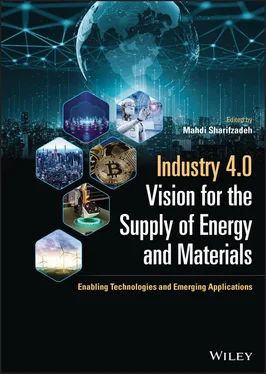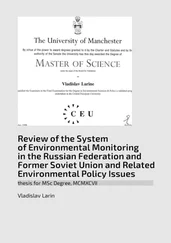Industry 4.0 Vision for the Supply of Energy and Materials
Здесь есть возможность читать онлайн «Industry 4.0 Vision for the Supply of Energy and Materials» — ознакомительный отрывок электронной книги совершенно бесплатно, а после прочтения отрывка купить полную версию. В некоторых случаях можно слушать аудио, скачать через торрент в формате fb2 и присутствует краткое содержание. Жанр: unrecognised, на английском языке. Описание произведения, (предисловие) а так же отзывы посетителей доступны на портале библиотеки ЛибКат.
- Название:Industry 4.0 Vision for the Supply of Energy and Materials
- Автор:
- Жанр:
- Год:неизвестен
- ISBN:нет данных
- Рейтинг книги:4 / 5. Голосов: 1
-
Избранное:Добавить в избранное
- Отзывы:
-
Ваша оценка:
- 80
- 1
- 2
- 3
- 4
- 5
Industry 4.0 Vision for the Supply of Energy and Materials: краткое содержание, описание и аннотация
Предлагаем к чтению аннотацию, описание, краткое содержание или предисловие (зависит от того, что написал сам автор книги «Industry 4.0 Vision for the Supply of Energy and Materials»). Если вы не нашли необходимую информацию о книге — напишите в комментариях, мы постараемся отыскать её.
Explore the impact of Industry 4.0 technologies on the supply chain with this authoritative text written by a leader in his field Industry 4.0 Vision for the Supply of Energy and Materials,
Industry 4.0 Vision for the Supply of Energy and Materials
Industry 4.0 Vision for the Supply of Energy and Materials — читать онлайн ознакомительный отрывок
Ниже представлен текст книги, разбитый по страницам. Система сохранения места последней прочитанной страницы, позволяет с удобством читать онлайн бесплатно книгу «Industry 4.0 Vision for the Supply of Energy and Materials», без необходимости каждый раз заново искать на чём Вы остановились. Поставьте закладку, и сможете в любой момент перейти на страницу, на которой закончили чтение.
Интервал:
Закладка:
1.10 Conclusion
Industry 4.0 is a blueprint that digitizes the value chain and is highly instrumental in bringing physical production processes and their inherent real-time control functionalities to life. An essential aspect of implementing Industry 4.0 is the seamless connectivity of all value creation factors: service user, marketplace, and service provider. This concept envisages smart environments that offer a certain degree of automated control and processing, with minimum human interventions. At the core of this networking and integrated data concept is seamless communication that connects industrial environments and production areas. Diverse wireless standards and technologies are available to accelerate the deployment of smart technologies in process control and automation applications.
In this chapter, we first reviewed the concept of Industry 4.0 along with its technological requirements and applications. Subsequently, we detailed wireless technologies and international standards in this context. Since each wireless solution has its own pros and cons, we compared them based on a set of technical performance metrics to assist in choosing the appropriate wireless communication for a given application. Considering that existing wireless systems will be complemented or replaced by new developments such as cellular networks and MTC communications, such technologies were also fully covered in this chapter. A list of objectives in terms of resource and service indicators was also provided for an efficient design of wireless networks in IIoT environment. Finally, MAC protocols and smart sensors were discussed to address the key issues in the design process of wireless connectivity in the industrial Internet. We also reviewed a number of future research trends and directions in wireless communication for Industry 4.0.
References
1 1 Roblek, V., Bach, M.P., Mesko, M., and Berton- Celj, A. (May 2013). The impact of social media to value added in knowledge-based industries. Kybernetes 42 (4): 554–568.
2 2 Schlechtendahl, J., Keinert, M., Kretschmer, F., Lechler, A., and Verl, A. (Feb 2015). Making existing production systems industry 4.0- ready. Prod. Eng. 9: 143–148.
3 3 Almada-Lobo, F. (2016). The Industry 4.0 revolution and the future of manufacturing execution systems (MES). J. Innov. Manag. 3: 16–21.
4 4 Kagermann, H., Lukas, W.-D., and Wolfgang, W. (2011). Industrie 4.0 – mitdem Internet er dinge auf dem wegzur 4. Industriellen revolution. VDI Nachrichten 13 (1): 2–3.
5 5 Kagermann, H., Wahlster, W., and Helbig, J. (Apr 2013). Recommendations for Implementing the Strategic Initiative Industrie 4.0 – Securing the Future of German Manufacturing Industry. Final report of the Industrie 4.0 working group, ACATECH – National Academy of Science and Engineering, Miinchen. https://www.din.de/blob/76902/e8cac883f42bf28536e7e8165993f1fd/recommendations-for-implementing-industry-4-0-data.pdf.
6 6 Horizon. (2020). European commission. Call for factories of the future. https://ec.europa.eu/programmes/horizon2020/en/news/call-factories-future-1.
7 7 European Factories of the Future Research Association (EFFRA). Factories of the Future. https://www.effra.eu/factories-future.
8 8 Evans, P. and Annunziata, M. (Jan 2012). Industrial Internet: Pushing the boundaries of minds and machines. General Electric. https://www.ge.com/news/sites/default/files/5901.pdf.
9 9 Industrial Valuechain Initiative. What is IVI (Industrial Value Chain Initiative)? https://iv-i.org/wp/en/about-us/whatsivi.
10 10 Pereira, A.C. and Romero, F. (2017). A review of the meanings and the implications of the industry 4.0 concept. Procedia Manuf. 13: 1206–1214.
11 11 Schmidt, R., Mohring, M., Harting, R.-C., Reichstein, C., Neumaier, P., and Jozinovic, P. (Jun 2015). Industry 4.0 – potentials for creating smart products: Empirical research results. In: Business Information Systems (ed. W. Abramowicz), 16–27. Springer.
12 12 Kagermann, H. (2015). Change through digitization—value creation in the age of Industry 4.0. In: Management of Permanent Change (ed. H. Albach, H. Meffert, A. Pinkwart, and R. Reichwald), 23–45. Springer Fachmedien Wiesbaden.
13 13 Radziwon, A., Bilberg, A., Bogers, M., and Madsen, E.S. (2014). The smart factory: Exploring adaptive and flexible manufacturing solutions. Procedia Eng. 69: 1184–1190.
14 14 Weyer, S., Schmitt, M., Ohmer, M., and Gorecky, D. (2015). Towards industry 4.0 – standardization as the crucial challenge for highly modular, multi-vendor production systems. IFAC- PapersOnLine 48 (3): 579–584.
15 15 Qin, J., Liu, Y., and Grosvenor, R. (2016). A categorical framework of manufacturing for industry 4.0 and beyond. Procedia CIRP 52: 173–178.
16 16 Glova, J., Sabol, T., and Vajda, V. (2014). Business models for the Internet of things environment. Procedia Econ. Fin. 15: 1122–1129.
17 17 Romero, D., Bernus, P., Noran, O., Stahre, J., and Fast-Berglund, A. (Sep 2016). The operator 4.0: human cyber-physical systems & adaptive automation towards human-automation symbiosis work systems. In: Advances in Production Management Systems. Initiatives for a Sustainable World (ed. I. Naas, O. Vendrametto, J.M. Reis, R.F. Goncalves, M.T. Silva, V.C. Gregor, and D. Kiritsis), 677–686. Springer International Publishing.
18 18 Hahn, T. (Aug 2014). Future of manufacturing: view on enabling technologies. Siemens Corporate Technology. https://opcfoundation.org/wp-content/uploads2014/09/3_140805_OPC_Foundation_Redmond_v7a_incl_Siemens_Slides_20140731.pdf.
19 19 Taiwan, D. (Sep 2015). Challenges and Solutions for the Digital Transformation and Use of Exponential. https://www2.deloitte.com/tw/en/pages/manufacturing/articles/industry4-0.html.
20 20 Posada, J., Toro, C., Barandiaran, I., Oyarzun, D., Stricker, D., De Amicis, R., Pinto, E. B., Eisert, P., Dollner, J., and Vallarino, I. (2015). Visual computing as a key enabling technology for Industrie 4.0 and industrial Internet. IEEE Comput. Graph. Appl. 35 (2): 26–40.
21 21 Zhou, K., Liu, T., and Lifeng, Z. (2015). Industry 4.0: towards Future Industrial Opportunities and Challenges. 2015 12th International Conference on Fuzzy Systems and Knowledge Discovery (FSKD), 2147–2152.
22 22 Hermann, M., Pentek, T., and Otto, B. (2016). Design Principles for Industrie 4.0 Scenarios. 2016 49th Hawaii International Conference on System Sciences (HICSS), 3928–3937.
23 23 Lee, J., Bagheri, B., and Kao, H.-A. (2015). A cyber-physical systems architecture for industry 4.0-based manufacturing systems. Manuf. Lett. 3: 18–23.
24 24 Francalanza, E., Borg, J., Constantinescu, C. (2017). A knowledge-based tool for designing cyber physical production systems. Comput. Ind. 84: 39–58.
25 25 Xu, L.D., He, W., and Li, S. (2014). Internet of Things in Industries: a Survey. IEEE Trans. Industr. Inform. 10 (4): 2233–2243.
26 26 Haller, S., Karnouskos, S., and Schroth, C. (2009). The Internet of things in an enterprise context. In: Future Internet – FIS 2008 (ed. J. Domingue, D. Fensel, and P. Traverso), 14–28. Springer Berlin Heidelberg.
27 27 Mourtzis, D., Vlachou, E., and Milas, N. (2016). Industrial big data as a result of IoT adoption in manufacturing. Procedia CIRP 55: 290–295.
28 28 Sisinni, E., Saifullah, A., Han, S., Jennehag, U., and Gidlund, M. (2018). Industrial Internet of things: Challenges, opportunities, and directions. IEEE Trans. Industr. Inform. 14 (11): 4724–4734.
Читать дальшеИнтервал:
Закладка:
Похожие книги на «Industry 4.0 Vision for the Supply of Energy and Materials»
Представляем Вашему вниманию похожие книги на «Industry 4.0 Vision for the Supply of Energy and Materials» списком для выбора. Мы отобрали схожую по названию и смыслу литературу в надежде предоставить читателям больше вариантов отыскать новые, интересные, ещё непрочитанные произведения.
Обсуждение, отзывы о книге «Industry 4.0 Vision for the Supply of Energy and Materials» и просто собственные мнения читателей. Оставьте ваши комментарии, напишите, что Вы думаете о произведении, его смысле или главных героях. Укажите что конкретно понравилось, а что нет, и почему Вы так считаете.












